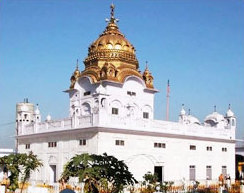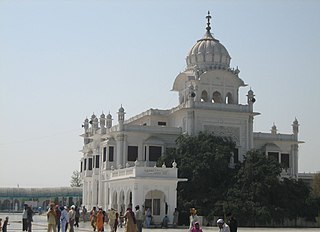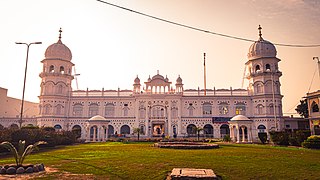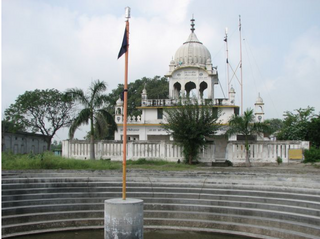
Nankana Sahib is a city and capital of Nankana Sahib District in the Punjab province of Pakistan. It is named after the first Guru of the Sikhs, Guru Nanak, who was born in the city and first began preaching here. Nankana Sahib is among the most important religious sites for the Sikh religion. It is located about 91 km (57 mi) west of Lahore and about 75 km (47 mi) east of Faisalabad. According to the census of 2017 the city has a population of 110,135 inhabitants. Until 2005, it was a part of the Sheikhupura District.

A gurdwara or gurudwara is a place of assembly and worship in Sikhism, but its normal meaning is "place of guru" or "home of guru". Sikhs also refer to gurdwaras as Gurdwara Sahib. People from all faiths and religions are welcomed in gurdwaras. Each gurdwara has a Darbar Sahib where the Guru Granth Sahib is placed on a takht in a prominent central position. Any congregant may recite, sing, and explain the verses from the Guru Granth Sahib, in the presence of the rest of the congregation.
The following outline is provides an overview of Sikhism, or Sikhi.

Sikhism is the fourth largest religion in Pakistan with a population of more than 15,000 Sikhs, mostly residing in Punjab and Khyber Pakhtunkhwa, accounting for 0.01% of the country's population. Sikhism has an extensive heritage and history in the country, although Sikhs form a small community in Pakistan today. Sikhism originated from what is now Punjab, Pakistan in the 15th century. Nankana Sahib, the birthplace of Guru Nanak, is located in Pakistan's Punjab province. Moreover, the place where Guru Nanak died, the Gurudwara Kartarpur Sahib is also located in the same province.

Dera Baba Nanak is a town and a municipal council in Gurdaspur district, in the state of Punjab, India. It is the sub-district headquarters of Dera Baba Nanak tehsil. It is 36 km away from Gurdaspur city, the capital of the district. Since November 2019, a corridor between India and Pakistan has been established at its shrine.

Sultanpur Lodhi is a city and a Municipal Council, just 17 miles Kapurthala city in the Kapurthala district in the Indian state of Punjab. The town is named after its founder, Bahlol Lodhi, the future Sultan of Delhi who renamed the town in 1443 C.E. during his time as governor of Punjab, and has also been mentioned in the Ain-e-Akbari. Sultanpur Lodhi is located on the south bank of a seasonal rivulet called Kali Bein, which runs 6 miles (9.7 km) north of the confluence of the Beas and Sutlej rivers of Punjab.

Sikh architecture is a style of architecture that was developed under the Sikh Confederacy and Sikh Empire during the 18th and 19th centuries in the Punjab region. Due to its progressive style, it is constantly evolving into many newly developing branches with new contemporary styles. Although Sikh architecture was initially developed within Sikhism its style has been used in many non-religious buildings due to its beauty. 300 years ago, Sikh architecture was distinguished for its many curves and straight lines; Keshgarh Sahib and the Harmandir Sahib are prime examples.

Gurdwara Nanak Shahi is the principal Sikh gurdwara (temple) Bangladesh, located in Nilkhet, Dhaka. It is located at the campus of the University of Dhaka and considered to be the biggest of the 9 to 10 gurdwaras in the country. The gurdwara commemorates the visit of Guru Nanak (1506–1507). It is said to have been built in 1830. The present building of the gurdwara was renovated in 1988–1989. The gurdwara was formerly called the Sujatpur Sikh Sangat and had been established by Udasis.

German Sikhs are a growing religious minority in Germany. The majority of German Sikhs have their roots from the Punjab, India with the remaining coming from the Afghan Sikh community or through conversion. The number of Sikhs is estimated to be between 25,000. Germany had the fifth highest Sikh population in Europe after United Kingdom (524,000), Italy (220,000), Portugal (35,000) and Spain (26,000).

Gurdwara Darbar Sahib Kartarpur, also called Kartarpur Sahib, is a gurdwara in Kartarpur, located in Shakargarh, Narowal District, in the Punjab province of Pakistan. It is built on the historic site where the founder of Sikhism, Guru Nanak, settled and assembled the Sikh community after his missionary travels and lived for 18 years until his death in 1539. It is one of the holiest sites in Sikhism, alongside the Golden Temple in Amritsar and Gurdwara Janam Asthan in Nankana Sahib.

Gurū Nānak, also known as Bābā Nānak, was an Indian spiritual teacher, mystic and poet, who is regarded as the founder of Sikhism and is the first of the ten Sikh Gurus.

Gurdwara Janam Asthan, also referred to as Gurdwara Nankana Sahib, is a highly revered gurdwara that is situated at the site where the founder of Sikhism, Guru Nanak, was born. The shrine is located in Nankana Sahib, Punjab, Pakistan.
A takht, or taḵẖat, literally means a throne or seat of authority and is a spiritual and temporal centre of Sikhism. There are five takhts, which are five gurudwaras that have a very special significance for the Sikh community. Three are located in Punjab whilst the remaining two are located outside of it.

Gurdwara Gurusar Sahib - a shrine which commemorates visit of Guru Hargobind Sahib and Guru Gobind Singh. Gurudwara Gurusar Sahib is located in village Lal Kalan (Ldh), Lal Kalan is a village near Neelon Bridge, Sirhind Canal; on Chandigarh-Ludhiana Road. Gurudwara Sahib, inside a walled compound has an octagonal shaped room, with the sanctum in the middle. Over the sanctum on the first floor there is a low domed room built in the same style. At Gurudwara Gurusar Sahib there is Sarovar, Beri Sahib and Barota Sahib with their own importance.

Guru Nanak Jhira Sahib is a Sikh historical shrine situated in Bidar, Karnataka. Gurdwara Nanak Jhira Sahib was built in 1948 and is dedicated to the first Sikh guru, Guru Nanak. Bidar has a very long association with Sikhism as this is the home town of Bhai Sahib Singh, one of the Panj Pyare, who offered to sacrifice their heads and were later baptised as the first members of the Khalsa.

The Kartarpur Corridor is a visa-free border crossing and religious corridor, connecting the Gurdwara Darbar Sahib, near Narowal in Pakistan to Gurudwara Dera Baba Nanak, Gurdaspur district, Punjab, India. The crossing allows devotees from India to visit the gurdwara in Kartarpur, Pakistan, 4.7 kilometres from the India–Pakistan border on the Pakistani side without a visa. However, Pakistani Sikhs are unable to use the border crossing, and cannot access Dera Baba Nanak on the Indian side without first obtaining an Indian visa or unless they work there.
Shahid Shabbir is a Pakistani historian, researcher and journalist. He is also radio host at Radio Sade Aala 87.8 FM in New Zealand. He is known for his work on discovering and restoring Sikh and Hindu religious places left in Pakistan after 1947 Partition of Punjab.

There are a number of sacred trees considered sacred in the Sikh religion. As many as fifty-eight Sikh shrines are associated with particular trees of importance, with up to nineteen tree species being represented amongst these sacred trees. Many of the sacred trees are associated with miraculous sakhis or historical events.























